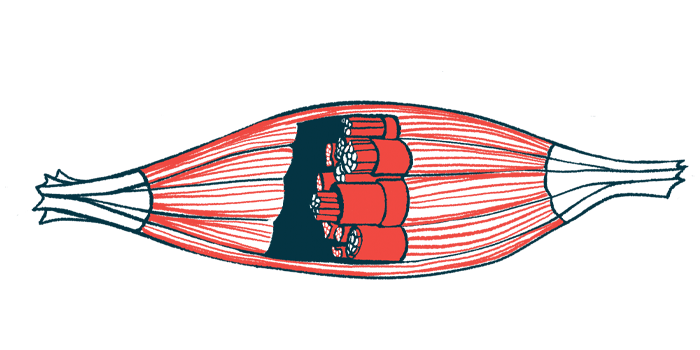Nerve impulse test seen to predict motor recovery after Zolgensma


Evaluating the strength of nerve cell impulses to muscles may be a good way of predicting motor skill recovery after Zolgensma (onasemnogene abeparvovec) treatment in infants with spinal muscular atrophy (SMA), a recent study suggests.
The research showed that compound muscle action potential (CMAP) amplitudes in the median nerve were able to accurately predict the likelihood that babies with SMA type 1 would be able sit without help six months after receiving the gene therapy.
“CMAP amplitude is a reliable, valid, and simple to perform in real life, biomarker for functional outcome in SMA type 1 symptomatic patients treated by gene therapy,” the researchers wrote.
The study, “A new score combining compound muscle action potential (CMAP) amplitudes and motor score is predictive of motor outcome after AVXS-101 (Onasemnogene Abeparvovec) SMA therapy,” was published in Neuromuscular Disorders.
CMAP amplitudes tend to fall over time in SMA patients
SMA is marked by the progressive degeneration of motor neurons, the specialized nerve cells that communicate with muscles to facilitate voluntary movements, leading to muscle weakness and wasting.
Zolgensma, an approved one-time gene therapy, has shown an ability to extend survival, improve motor function, and prevent the need for ventilation assistance in infants with SMA.
However, some symptomatic children still show “suboptimal” motor development after treatment, failing to reach key motor milestones, the researchers noted. There is a need to better understand factors that might predict children at risk of poorer outcomes, who may benefit from other SMA therapies.
Measuring CMAP amplitudes may be one way of doing so. In the approach, motor nerve cells are stimulated and the electrical response of the muscle that they innervate is measured. A lower response from the muscle (lower CMAP amplitude) is thought to reflect fewer intact and available motor neurons.
This non-invasive measure typically correlated well with other indicators of disease severity. CMAP amplitudes also decrease over time in SMA patients, and they tend to be lower in patients with SMA types marked by earlier onset and faster progression, and in patients who aren’t able to walk.
Previous work indicated that Zolgensma is associated with increased CMAP amplitudes in the ulnar nerve (a nerve in the forearm that controls wrist and finger movement) in infants with SMA type 1.
To determine whether CMAP amplitudes could help to distinguish patients with poorer responses to Zolgensma, researchers evaluated the long-term outcomes, as well as changes in CMAP amplitudes across multiple nerves, in 13 children with SMA type 1 given the gene therapy at a single center in France.
The children, with a mean age of 227 days (about 7.5 months), underwent CMAP testing in four nerves: the ulnar and the median nerves of the upper arm, and the tibial and fibular nerves, both in the lower leg. Overall, six children were able to sit unaided at six months post-treatment, and two others could do so at one year.
CMAP amplitudes tended to increase over time after Zolgensma treatment. In particular, median nerve CMAP amplitudes were significantly higher a year after Zolgensma in children with type 1b and type 1c SMA. Type 1c typically has a later onset and is less severe.
The Children’s Hospital of Philadelphia Infant Test of Neuromuscular Disorders (CHOP INTEND) scores, a standard measure of motor function in infants with SMA type 1, also generally increased over time, indicating improvements.
Initial CMAP amplitudes link with walking skills 6 months post-treatment
Notably, higher median nerve CMAP amplitudes before treatment were predictive of a child’s ability to sit unaided six months later, with an accuracy of 90%. CHOP INTEND scores had a predictive accuracy of 93%, whereas the two measures together achieved 98% predictive power.
A year after Zolgensma treatment, CHOP INTEND no longer was as good at predicting a child’s ability to sit unaided (83%). At that time, a combination of tibial and median CMAP amplitudes were better predictors, with an accuracy of about 96%, the study reported.
To confirm their findings, CMAP amplitudes were examined in the second group of 12 children, treated with Zolgensma at other centers in France. In this group, median nerve CMAP amplitudes were 94% accurate at predicting sitting ability after six months, while the accuracy of CHOP INTEND was 75%.
Across both groups, no child with CHOP INTEND scores less than 30 out of 64, and a median nerve CMAP less than 0.5 millivolts (mV) at the study’s start, achieved unaided sitting at six months post-treatment.
Overall, the results suggest that higher median nerve CMAP amplitudes before Zolgensma, with a clinical cutoff of 0.5 mV, may predict better motor recovery with Zolgensma’s use, according to the researchers.
“Median CMAP amplitude is a reliable, valid, and simple to perform in real life, biomarker for functional outcome in SMA type 1 symptomatic patients treated by gene therapy,” the researchers concluded.
“We propose a simple threshold of 0.5 mV at baseline that may imply that over this limit, motor recovery is expected,” they added. “This could have practical implication in the French treatment strategy to target good responders.”
The post Nerve impulse test seen to predict motor recovery after Zolgensma appeared first on SMA News Today.


